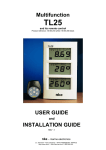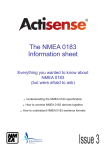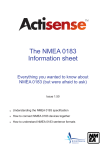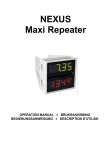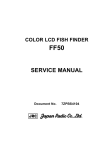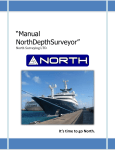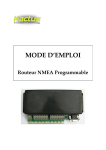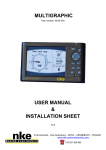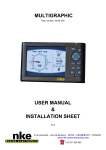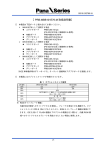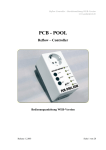Download Raymarine NMEA BRIDGE Specifications
Transcript
SeaTalk1 <-> NMEA Bridge Installation and Operation Manual Version : Bridge128SD Software Version 3.01 June 2013 1 SeaTalk is Reg. Trademark of Raymarine Inc. © 2013 All Rights Reserved © 2013 Alle Rechte vorbehalten Hw Version 128-1.0 / Sw Version 3.01 Page 1 of 28 http://www.gadgetPool.de [email protected] Credits / Warning / Disclaimer The protocol converter is a RESEARCH PROJECT It is used for research on data communication, computer communication and data conversion on computers used on board boats. Hard- and Software are still under development and have NOT been fully tested. Malfunctions of the protocol converter and of any connected device are possible at any time. The protocol converter could cause damage to connected devices. Liability cannot be accepted for any damages, personal injuries or malfunctions caused by the converter. There are no SeaTalk technical specifications available from the manufacturer. We have used the Technical Reference of the SeaTalk protocol, compiled by Thomas Knauf. See http://www.thomas-knauf.de/seatalk.htm .Thank you to Thomas Knauf for his work. Do not use as primary navigation device This device should be used only as an aid to navigation and should never replace commonsense and 'good seamanship' . Always maintain a permanent watch so that you can respond to any situations as they develop. This device and the cables connected should be placed : • At least 2 meters from any equipment transmitting radio signals. (e.g. VHF, Antennas,.. ) • More than 2 meters from the path of a radar beam or SSB transmitting equipment Always check the installation and function of the SeaTalk NMEA bridge and of any other navigation device on board before going to sea. SeaTalk NMEA Bridge 128SD Sw Version 3.01 Page 2 of 28 SeaTalk <-> NMEA Bridge Contents CREDITS / WARNING / DISCLAIMER 2 OVERVIEW 4 CONNECTIONS 5 POWER SUPPLY SEATALK CONNECTION NMEA CONNECTION RS232 CONNECTION USB PC PORT 5 5 6 7 8 DISPLAY AND KEYS 9 DISPLAY KEY FUNCTIONS : INSTALLATION AND COMMISSIONING MOUNTING USB DRIVER INSTALLATION USB COM PORT ASSIGNMENT NMEA INPUT- AND OUTPUT PORT SELECTION CONNECTION EXAMPLES DATA FLOW NMEA INPUT NMEA OUTPUT SEATALK INPUT SEATALK OUTPUT SAME TYPE OF DATA ON NMEA & SEATALK SPECIAL FUNCTIONS AND CONFIGURATION CONFIGURATION SCREEN CONFIGURATION EXAMPLE CONFIGURATION COMMANDS CONFIGURATION ID'S SPECIAL NMEA LIKE COMMANDS THE $STALK SENTENCE $SWVERSION SOFTWARE UPDATE BOOTSTRAP LOADER METHOD 9 10 11 11 12 12 13 13 14 15 16 17 18 18 19 19 20 21 22 24 24 24 25 25 SEATALK & NMEA CONVERSION TABLE 26 TECHNICAL DATA 27 NEWS AND INFO ON THE WEB. 27 ASCII TABLE 28 SeaTalk NMEA Bridge 128SD Sw Version 3.01 Page 3 of 28 SeaTalk <-> NMEA Bridge Overview The converter interconnects two different data communication systems – SeaTalk 2 and NMEA 0183. Information from the SeaTalk network is transformed into NMEA Data and sent to the NMEA ports. Information from the NMEA ports is transformed into SeaTalk data and sent to the SeaTalk bus. SeaTalk and NMEA data are shown on a LCD display. This converter has detachable terminals for : Power supply SeaTalk port ( SeaTalk IN (galvanic isolated) and OUT (galvanic isolated)) NMEA port ( NMEA IN (galvanic isolated) and OUT ) RS232 port ( NMEA IN and OUT ) USB computer port ( NMEA IN and OUT ) Power SeaTalk RS232 NMEA USB Power 12 Volt 2 SeaTalk is Reg. Trademark of Raymarine Inc. SeaTalk NMEA Bridge 128SD Sw Version 3.01 Page 4 of 28 SeaTalk <-> NMEA Bridge Connections Power Supply The bridge takes it’s power supply from +12V and GND. 12 Volt DC power supply (e.g. from battery) must be protected with a 1 amp circuit breaker or fuse. The bridge consumes approx 60 mA in idle mode, 50 mA when backlight is switched off and can consume temporarily up to 100 mA when sending data. GND +12 Volt SeaTalk connection +12 Volt Red SeaTalk Data Yellow GND Silver A 3-Pin terminal is used for the connection to the SeaTalk bus. Please double check for correct connection. A wrong connection could damage the converter or other devices on the SeaTalk Bus. SeaTalk NMEA Bridge 128SD Sw Version 3.01 Page 5 of 28 SeaTalk <-> NMEA Bridge NMEA Connection The board has 1 * NMEA-IN3 1 * NMEA-OUT port. The NMEA-IN port is used to receive data from standard NMEA devices like GPS etc. This standard NMEA devices usually have terminals marked with NMEA OUT+, NMEA OUT-. ( On some devices the ports are marked NMEA-OUT-A, NMEA-OUT-B ) NMEA-OUT - NMEA-OUT + NMEA-IN + NMEA-IN - The NMEA-OUT port is used to send data to standard NMEA devices like GPS, VHF etc. This standard NMEA devices usually have terminals marked with NMEA IN+, NMEA IN ( On some devices the ports are marked NMEA-IN-A, NMEA-IN-B ) 3 IN-Port can be switched between NMEA-IN and RS232 RxD. See page 13 - NMEA Input- and Output Port selection SeaTalk NMEA Bridge 128SD Sw Version 3.01 Page 6 of 28 SeaTalk <-> NMEA Bridge RS232 Connection The board has 1 * RS232 port for reading4 and writing NMEA data The RS232 port is used to send and receive data to/from a standard NMEA device that has an RS232 port instead of a NMEA port. Many GPS devices, i.e. hand-held GPS, have RS232 ports instead of NMEA ports. The RS232 port can also be used to connect the bridge to a computer that only has a serial port but no USB port. TxD RxD GND 4 IN-port can be switched between NMEA-IN and RS232 RxD. See page 13 - NMEA Input- and Output Port selection SeaTalk NMEA Bridge 128SD Sw Version 3.01 Page 7 of 28 SeaTalk <-> NMEA Bridge USB PC Port The board has 1 * USB port for PC connection. The USB Port speed is currently fixed to 4800 Baud. The bridge has one USB port. It can be used to connect it to a computer or notebook. After connection the bridge, a new serial port will be available on your computer ( See Page 12 – Com Port assignment ) With this serial port, the computer can act as a NMEA sender and as a NMEA receiver. It can receive data from the devices attached to the bridge, and it can send data to this devices. In every navigation software, an option can be found to select the serial port to be used. SeaTalk NMEA Bridge 128SD Sw Version 3.01 Page 8 of 28 SeaTalk <-> NMEA Bridge Display and Keys The SeaTalk NMEA bridge has a 4 * 20 character display and 7 push buttons. Display The display shows SeaTalk and NMEA data. It has 4 pages, selectable by Key-1 to Key-4 or by Key-Up and Key-Down Page 1 Speed t. water Depth Position Position over ground Temperature Course true Course magnetic Page 2 Wind speed Wind direction Course magnetic Course true Trip mileage Total mileage UTC Time Page 3 Waypoint data From WP Name XTE Distance Speed t. water To Wp Name Bearing to Wp Course Speed o. ground Page 4 Speed over ground SeaTalk NMEA Bridge 128SD Sw Version 3.01 Page 9 of 28 SeaTalk <-> NMEA Bridge Key functions : Key Function Key 1 Key 2 Key 3 Key 4 Select display page 1 Select display page 2 Select display page 3 Select display page 4 Key Down Select next display page Key Up Select previous display page Key Enter Display illumination on/off Key Enter pressed Configuration menu for 5 seconds Key Down pressed NMEA & RS232 loopback test for 5 seconds SeaTalk NMEA Bridge 128SD Sw Version 3.01 Page 10 of 28 SeaTalk <-> NMEA Bridge Installation and commissioning Mounting Before starting the installation, you should take some time to find the best position for the instrument. Of course it should be placed so that the display is easily readable and the push buttons are easily accessible. It must be placed in a dry and ventilated place. Make sure that there is enough space behind the instrument to accommodate the instrument connectors and cables. The instrument and it's cables must be placed at least 1 meter (3 ft) from any equipment transmitting or cables carrying radio signals. In case of SSB radio, the distance should be at least 2 meters (6 ft). • • • • • • • • Apply the drill template (supplied at the rear of this handbook). Drill out the four 3mm holes. Cut out the clearance hole. Remove the template. Remove the cover for the screws by gently sliding it sidewards. Mount the instrument into the panel. Fix the instrument with 4 * 3mm screws. Put back on the cover on both sides. 3mm holes SeaTalk NMEA Bridge 128SD Sw Version 3.01 cover Page 11 of 28 SeaTalk <-> NMEA Bridge USB Driver installation Depending on the operating system of the computer, it might be necessary to install a driver software. The bridge is using a standard FTDI USB serial converter chip. Drivers for this chip can be found on the CD and on the FTDI webpages. (http://www.ftdichip.com/FTDrivers.htm) Linux A reasonable modern LINUX system does not need a special driver installation. The FTDI chip will be recognized and the system will provide a new serial port. Usually this is /dev/ttyUSB0. If there is already another USB-serial converter attached to your system, the new port will be /dev/ttyUSB1 or /dev/ttyUSB2 etc. . Windows On a MS-Windows system, it might be necessary to install the driver software. If there is already some other devices using FTDI chips, this driver will be available already. Otherwise the driver has to be installed. You'll find the driver software on the CD in the subdirectory /DRIVERS. The bridge has a standard FTDI USB chip. There are drivers for every version of MSWindows available on the FTDI website. USB Com Port assignment MS-Windows assign a COM port automatically. In order to find out which port has been assigned, please check the MS-Windows device manager. In the device manager you'll find “Ports – COM & LPT “. In this example, windows has put the SeaTalk NMEA bridge on COM4 SeaTalk NMEA Bridge 128SD Sw Version 3.01 Page 12 of 28 SeaTalk <-> NMEA Bridge NMEA Input- and Output Port selection All OUT-ports are always enabled : The Out-ports - NMEA-OUT, RS232 TxD and USB - are always enabled. The SeaTalk NMEA bridge always sends data to the NMEA-OUT port, the RS232 TxD pin and to the USB port. You can - for example - send data from the SeaTalk NMEA bridge to a Computer (USB) and a GMDSS radio (NMEA-OUT) at the same time. The IN-port is selectable : The bridge can receive NMEA data from either NMEA-IN or from RS232 RxD pin. It can not receive data from NMEA-IN and RS232 RxD at the same time. The user has to select, which IN-port is used for receiving NMEA data. Input port is selected in the configuration screen or with special command $SNBSE See chapter “Special functions and configurations” 34 0 = Input is RS232 port 1 = Input is NMEA port Connection examples Hand-held GPS to bridge Bridge to PC GPS with SeaTalk NMEA Bridge RS232 port RS232 port Serial Data out RxD GND TxD GND SeaTalk NMEA Bridge RS232 port SeaTalk NMEA Bridge 128SD Sw Version 3.01 TxD RxD GND TxD Pin 3 RxD Pin 2 GND Pin 5 PC / NOTEBOOK Serial port Page 13 of 28 SeaTalk <-> NMEA Bridge Data Flow SeaTalk Device Seatalk<-> NMEA Bridge NMEA OUT PORT OUT+ IN- SeaTalk NMEA IN PORT OUT- IN- IN+ IN+ OUT- OUT+ NMEA-DEVICE Receiver i.e. GMDSS Radio NMEA-DEVICE Transmitter USB USB Port Computer RS232 TxD RxD GND RxD TxD GND RS232 Device ( PC, GPS ...) i.e. GPS Received SeaTalk data are translated into NMEA and sent to NMEA-OUT port and to the RS232 TxD pin and to the USB port. Received NMEA data from the NMEA-IN port are sent to NMEA-OUT and to the RS232 TxD pin and USB port. They are also translated into SeaTalk data and send to the SeaTalk port. Received NMEA data from the RS232 RxD pin are sent to NMEA-OUT and to the RS232 TxD pin and USB port. They are also translated into SeaTalk and send to the SeaTalk port. Received NMEA data from the USB Port are sent to NMEA-OUT port and to the RS232 TxD pin. They are also translated into SeaTalk and send to the SeaTalk port. SeaTalk NMEA Bridge 128SD Sw Version 3.01 Page 14 of 28 SeaTalk <-> NMEA Bridge NMEA Input NMEA sentences can be received from the NMEA-IN or RS232 port and from the USB port. Processing of NMEA data starts, when a complete NMEA sentence has been received. If the received sentence contains a checksum, this checksum is used to check for communication errors. If the checksum does not match the sentence, the received NMEA sentence is discarded. If the sentence does not contain a checksum, the sentence is always regarded as valid. After complete reception and checksum verification the sentence is sent to the NMEA-OUT port, to the RS232 port and to the USB port. (This function can be switched off by control setting – see below ) If the received sentence is known to the system, the sentence information is extracted and processed. Processed data are shown on the display and sent to the SeaTalk port. At this time the following NMEA sentences can be received: NMEA ID $xxAPB $xxBWC $xxDBT $xxDPT $xxGLL $xxGGA $xxHDM $xxHDG $xxMWV $xxMTW $xxRMC $xxRMB $xxVHW $xxVLW $xxVTG $xxVWR $xxZDA Description Autopilot sentence "B" Bearing and distance to waypoint Depth below transducer Depth below keel Position # of satellites Heading magnetic “ “ Wind angle wind speed Water temperature Speed over ground, course over ground, Latitude, longitude, time, date Route & waypoint Information Speed through water Total / Trip mileage Velocity / Course made good Relative wind speed and angle Date & time Special NMEA-like sentences $STALK Special SeaTalk datagram $SNBSE Board configuration $SWVERSION Display board software version $SWUPDATE Update board software SeaTalk NMEA Bridge 128SD Sw Version 3.01 Page 15 of 28 SeaTalk <-> NMEA Bridge NMEA Output All valid NMEA sentences – whether processed by the converter or not – are forwarded to the NMEA-OUT port and to the USB Port. If the NMEA-OUT port is busy, the sentence is temporarily stored in memory and transmitted as soon as the NMEA-OUT port becomes free. NMEA input SeaTalk input USB + (NMEA-IN or RS232 RxD) The converter also continuously checks for new incoming SeaTalk data. Incoming SeaTalk data is converted to NMEA Data and transferred to the NMEA-OUT and the USB port. SeaTalk -> NMEA translation NMEA output NMEA-OUT RS232 TxD USB The following NMEA sentences can be sent : $IIDBT $IIDPT $IIVHW $IIMTW $IIVLW $IIMWV $IIHDM $IIRMC $IIRSA Depth below transducer Optional $IIDPT can be sent instead of $IIDBT Speed t. water Water temperature Total / Trip mileage Wind angle & wind speed ( true and apparent ) Heading compass Speed over ground, course over ground, latitude, longitude, UTC time, date Optional an additional $IIGLL sentence can be sent for position information Rudder angle $STALK $SNBSE special SeaTalk datagram special system configuration datagram $IIGLL SeaTalk NMEA Bridge 128SD Sw Version 3.01 Page 16 of 28 SeaTalk <-> NMEA Bridge SeaTalk Input When a SeaTalk datagram was received, the system checks if this datagram is known and should be processed. When the datagram is known, the datagram parameters are extracted, stored and converted to an NMEA sentence. Any unknown datagram is ignored. ( Exception: $STALK is sent even for unknown datagrams ) At this time the following SeaTalk datagrams can be received. 00 Depth 10 Wind angle 11 Wind speed 20 Speed through water 21 Trip mileage 22 Total mileage 23 Water temperature 25 Total & trip mileage 26 Speed through water 27 Water temperature 30 Lamp intensity 50 Latitude 51 Longitude 52 Speed over ground 53 Course over ground 54 UTC time 56 Date 58 Latitude & Longitude 84 Compass heading 89 Compass ST40 heading 9C Compass heading & rudder position SeaTalk NMEA Bridge 128SD Sw Version 3.01 SeaTalk Input SeaTalk -> NMEA translation NMEA Output Page 17 of 28 SeaTalk <-> NMEA Bridge SeaTalk Output The converter periodically checks if any new data has arrived from one of the NMEA- or the USB port. Newly arrived data are converted to SeaTalk and written to the SeaTalk. The bridge checks if the SeaTalk bus is free, or it is currently used by any other instrument. If the bus is in use, the converter waits for a while, and tries again. Collision detection Every single bit sent out to the SeaTalk bus is read back again and checked for successful transmission. If the transmission was corrupted, the transmission is stopped immediately. When the bus becomes free, the transmission will be started again. At this time the following SeaTalk data can be sent 00 10 11 20 25 27 30 50 51 52 53 54 56 57 85 82 89 9E A2 Depth Wind angle Wind speed NMEA Input Speed through water Total & Trip mileage NMEA -> SeaTalk Water temperature translation Lamp intensity Latitude SeaTalk Output Longitude Speed over ground Course over ground Time Date Number of sats, DD horiz. dilution of position Navigation to waypoint info Target waypoint name Compass ST40 heading Waypoint definition Arrival info Same type of Data on NMEA & SeaTalk Information available from like instruments on both buses ( SeaTalk & NMEA ) are not converted. Example: We have a depth sounder on the SeaTalk bus and another depth sounder on the NMEA bus. So, on both sides depth information is available. In this case no depth information in transferred from one bus to the other. ( If depth information is not updated within 30 sec. on one bus, sending to the other bus is activated again. ) SeaTalk NMEA Bridge 128SD Sw Version 3.01 Page 18 of 28 SeaTalk <-> NMEA Bridge Special functions and configuration Configuration screen The SeaTalk NMEA converter can be configured to meet the users requirements. The settings are stored in an internal EEProm. The configuration can be set in the configuration screen. → To enter the configuration screen, press key ENTER for 5 seconds. Settings are changed by using Key-1 to Key-4,Key-UP, Key-DOWN and Key-ENTER Function ID Value Select Function ID Change Value Key-UP = previous ID Key-DOWN = next ID Key-1 = value plus Key-2 = value minus Key-3 = reset value to factory default Key-4 = configuration is finished Select ID you would like to change using Key-UP / Key-DOWN Change value for this ID with Key-1 / Key-2 Finish configuration with Key-4 → For a list of function ID's and values – see page 22. SeaTalk NMEA Bridge 128SD Sw Version 3.01 Page 19 of 28 SeaTalk <-> NMEA Bridge Configuration example Example 1: In this example we configure the bridge, so that the NMEA baudrate is changed to 38400 baud. – – – – Find function ID for baudrate in table on page 22. Function ID for baudrate is 1 Find value for 38400 baud in table on page 22. Value for 38400 baud is 8 1 – – – – Set NMEA port baudrate 1 = 300 baud 2 = 600 baud 3 = 1200 baud 4 = 2400 baud 5 = 4800 baud ( Default ) 6 = 9600 baud 7 = 19200 baud 8 = 38400 baud Enter Configuration menu by pressing Key-ENTER for 5 seconds. Press Key-DOWN. You will see ID: 1 = 5 Press Key-1 until you see ID:1 = 8 Press Key-4 to leave configuration menu. After power off/on, the NMEA baudrate will be set to 38400. Example 2 : In this example we configure the bridge, so that it will read NMEA data from it's RS232-RxD port instead of it's NMEA-IN port. – – – – Find function ID for NMEA-IN port in table on page 22. Function ID for baudrate is 34 Find value for RS232 port in table on page 22. Value for RS232 port is 0 34 – – – 0 = Input is RS232 port 1 = Input is NMEA port Enter Configuration menu by pressing Key-ENTER for 5 seconds. Press Key-DOWN until you will see ID: 34 = 1 Press Key-2 until you see ID: 34 = 0 Press Key-4 to leave configuration menu. After power off/on, the NMEA-IN port will be RS232 port. SeaTalk NMEA Bridge 128SD Sw Version 3.01 Page 20 of 28 SeaTalk <-> NMEA Bridge Configuration commands The SeaTalk NMEA converter can be configured to meet the users requirements. The configuration is made by sending a NMEA-like sentence. The settings are stored in an EEProm. The configuration sentence is : $SNBSE,address,data<CR><LF> ( Optionally a checksum can be appended $SNBSE,address,data*XX<CR><LF>) ( SNBSE = SeaTalk NMEA Bridge Set Eeprom ) Configuration settings a read, when the bridge gets switched on. So when you change the configuration, you need to switch it off/on to activate the changes. How to set the configuration Connect the bridge to a PC using the USB port. Open a terminal program ( i.e. hypertern ) and set it to 4800 baud, 8 bit, no parity, no handshake. Type “ $xxx “ and press ENTER Bridge responds with “ $xxx “. When you receive the $xxx, connection to your bridge is established and working properly. If $xxx does not appear after you pressed ENTER, check connection, setting of com-port, baudrate etc. Example : In this example, we configure the bridge, so that every incoming SeaTalk sentence will be sent to the PC as $STALK,xx,yy sentence. In your terminal program enter $SNBSE,0,1 The bridge will respond with $SNBSE,0,1 Next time you switch the bridge on, it will send every incoming SeaTalk sentence to the PC as a $STALK,xx,yy,zz … sentence. How to read current setting In your terminal program, enter $SNBSE,Function-Id The bridge will respond with $SNBSE,Function-Id,data → For a list of function ID's and values – see page 22. SeaTalk NMEA Bridge 128SD Sw Version 3.01 Page 21 of 28 SeaTalk <-> NMEA Bridge Configuration Id's Function Value ID 0 1 = Send out every incoming SeaTalk datagram as "$STALK....." to NMEA 0 = Do not generate $STALK,xx,yy sentence for each incoming SeaTalk datagram If you don’t really need this function – better switch if OFF. It causes additional load on the NMEA Bus. 1 Set NMEA port baudrate 1 = 300 baud 2= 600 baud 3= 1200 baud 4 = 2400 baud 5 = 4800 baud ( Default ) 6 = 9600 baud 7 = 19200 baud 8 = 38400 baud any other value defaults to 4800 baud Baud rate is changed at next start of the converter Baud rate of the USB port is currently set fixed to 4800 Baud. 2+3 4 5 6 7 8 9 10 11 12 Prefix for generated NMEA sentence - Character 1+2 Every NMEA sentence generated from the system begins with this two letters Default = “II” ( Integrated Instrumentation ) WARNING: You have to enter the ASCII value of the character, not the character itself. Example : To set character 1 to “I” and character 2 to “A” $SNBSE,2,73 ( Character “I” is a 73 in ASCII ) $SNBSE,3,65 ( Character “A” is a 65 in ASCII ) See ASCII table 1= Echo every incoming NMEA sentence to NMEA Out port 2= Echo every incoming NMEA sentence to USB port 3= Echo every incoming NMEA sentence to USB port and NMEA port 0 = Do not echo incoming NMEA sentences N.A: 1 = Send $IIVHW sentence when new data from SeaTalk arrives 0 = Do not send $IIVHW sentence 1 = Send $IIHDM sentence when new data from SeaTalk arrives 0 = Do not send $IIHDM sentence 1 = Send $IIMWV sentence when new data from SeaTalk arrives 0 = Do not send $IIMWV sentence 1 = Send $IIDBT sentence when new data from SeaTalk arrives 0 = Do not send $IIDBT sentence 1 = Send $IIMTW sentence when new data from SeaTalk arrives 0 = Do not send $IIMTW sentence 1 = Send $IIVLW sentence when new data from SeaTalk arrives 0 = Do not send $IIVLW sentence 1 = LCD light on/off is sent to SeaTalk? 0 = Do not send light on/off to SeaTalk SeaTalk NMEA Bridge 128SD Sw Version 3.01 Page 22 of 28 SeaTalk <-> NMEA Bridge 13 14 15 16 17 18 19 20 21 22 23+24 25 26 27 28 29 30 31 32 33 34 35 1 = Send welcome message after power up 0 = Do not send welcome message 0 = Speed over ground from NMEA input is sent to SeaTalk as speed over Ground and as speed through water ( Needed for ST60 Wind instrument, that does not recognize speed over ground ) 1 = Normal operation. No special SOG => STW handling ) ( default ) ( See Webpage www.gadgetPool.de for more on this special ST60 Wind function. 0 = Every incoming SeaTalk datagram is sent to NMEA as "$STALK,xxx,yyy – no matter if the system can interpret the SeaTalk data or not. 1 = Normal operation. Only SeaTalk sentences known to the system are echoed as $STALK,xxx,yyy Only valid if function id “0” is switched on. 0 = Don’t send any data to the SeaTalk port. SeaTalk port is READ-ONLY 1 = Send data to SeaTalk 0 = Display wind speed in knots. 1= Display wind speed in m/s 0 = Don’t send SOG to SeaTalk 1 = Send SOG to SeaTalk 0 = Don’t send position to SeaTalk 1= Send position to SeaTalk 0 = Display depth on SeaTalk instrument in feed, 1 = display in meters 1=set time only with NMEA ZDA sentence 0=set time also via RMC sentence ... (time of last position fix) 0=send only RMC sentence for position to NMEA 1=send GLL and RMC sentence for position to NMEA 23+24 Offset of depth transducer. In mm ( +- 1000th Meter ) If this value is set to -1, the bridge will send DBT NMEA sentence and no offset will be used. If this values is set to something between -32000 to 32000, the bridge will produce DPT sentences including the offset. Reserved ( used for SeaTalk-NMEA-Link ) 1 = send NMEA RSA sentence for rudder angle data 0 = don’t send RSA sentence 0 = no bit set = Start display normal 1 = bit 1 set = Start after boot-up with display page 3 Not used 1 = send waypoint data to SeaTalk 0 = don't send waypoint data to SeaTalk 0 = Send NMEA Cog as COG and CMAG to SeaTalk. 1 = 1 = don't combine Not used Not used Calculate TRUE Wind data and send as $IIMWV Sentence 0 = No True wind calculation 1 = True wind calculation from water speed 2 = True wind calculation from SOG 0 = Input is RS232 port 1 = Input is NMEA port 0 = Display SOG as BigDigits in km/h on display page 4 1 = Display SOG as BigDigits in knots on display page 4 SeaTalk NMEA Bridge 128SD Sw Version 3.01 Page 23 of 28 SeaTalk <-> NMEA Bridge Special NMEA like commands The $STALK sentence The converter can process a special NMEA-like sentence. With this special sentence any SeaTalk command can be sent to SeaTalk. $STALK,cc,p1,p2..,pn*xx cc = SeaTalk command p1 = Parameter 1 p2 = Parameter 2 .. *xx = NMEA checksum ( optional ) . Example : Switch on display illumination on all devices on the SeaTalk network. Enter $STALK,30,00,0C Switch off display illumination on all devices on the SeaTalk network. Enter $STALK,30,00,00 This special sentence will be sent to the NMEA bus for every received SeaTalk datagram – regardless as to whether it was recognized and processed or not. ( This function can be switch off by control setting – see below ) The $SWVERSION command $SWVERSION<ENTER> Display software version. SeaTalk NMEA Bridge 128SD Sw Version 3.01 Page 24 of 28 SeaTalk <-> NMEA Bridge Software update The board software can be updated by using the built in Bootstrap-Loader function. If you find anything missing in the software, if you should find any software errors or if you have new ideas – just sent a mail to [email protected] New / revised software can be sent by E-Mail and the SeaTalk NMEA bridge owner can update the controller software him/herself. Bootstrap method advantages : No hardware programmer needed. Just a USB connection to PC and a PC software is needed. Fuses and bootstrap software can not be erased accidentally. Latest software versions can be found at http://www.gadgetPool.de Bootstrap Loader Method Connect the SeaTalk NMEA bridge to your PC ( using USB Port ) Open a terminal program ( i.e. hypertern ) and set it to 4800 baud, 8 bit, no parity, no handshake. Type “ $xxx “ and press ENTER Bridge responds with “ $xxx “. When you receive the $xxx, connection to your bridge is established and working propperly. If $xxx does not appear after you pressed ENTER, check connection, setting of com-port, baudrate etc. Enter $SWUPDATE The bridge will respond with Software Update Function will start in 40 sec. ... Close the terminal program. Start the supplied bootstrap software (Megaload ) on the PC. Open the image file you would like to program into the bridge. Select your serial port in bootstrap software Select 9600 baud After the 40 sec timeout, the bootstrap software finds the SeaTalk NMEA bridge and flashes the new software. The default timeout of 40 seconds can be adjusted. Just enter $SWUPDATE,xxx , where xxx is the timeout in seconds. SeaTalk NMEA Bridge 128SD Sw Version 3.01 Page 25 of 28 SeaTalk <-> NMEA Bridge SeaTalk & NMEA conversion Table Function Depth SeaTalk ID NMEA 0 DBT Stalk -> NMEA X NMEA->Stalk X X Speed t. water 20 VHW X Speed t. water 26 VHW X Trip mileage 21 VLW X Total mileage 22 VLW X Water temperature 23 MTW X Water temperature Total / Trip mileage 27 25 MTW VLW X X X X Wind angle 10 MWV X X Wind speed 11 MWV X X Compass 84 Compass ST40 89 HDM (VHW) HDM Speed over ground 52 RMC Course over ground 53 Lamp intensity 30 Latitude (See SNBSE,14) X X X X RMC X X 51 RMC X X Push button X Latitude 51 GLL Longitude 50 RMC Longitude 50 GLL UTC time UTC time # of sats Date Date Special NMEA->ST Special config. 54 54 57 56 56 any RMC ZDA GGA RMC ZDA $STALK - $SNBSE SeaTalk NMEA Bridge 128SD Sw Version 3.01 X X X X X X X X X X X X X X Page 26 of 28 SeaTalk <-> NMEA Bridge Technical data Instrument Width Height Depth Weight : : : : Clearance hole Width Height : : 141.5 mm 75.0 mm 37.5 mm 165.0 grams 104 mm 66 mm Minimum cable clearance behind panel : 40 mm Supply voltage Current consumption : 8 to 30 Volt DC : 60 mA idle, 50 mA backlighting off, 100 mA peak (12 Volt) News and Info on the web. If you have any question or suggestions – there is a SeaTalk NMEA bridge user forum on our web page. http://www.gadgetPool.de The software will be improved constantly. Please check http://www.gadgetpool.de for the latest software version. SeaTalk NMEA Bridge 128SD Sw Version 3.01 Page 27 of 28 SeaTalk <-> NMEA Bridge ASCII Table Upper case letters Character A B C D E F G H I J K L M N O P Q R S T U V W X Y Z Lower case letters a b c ……………….. x y z Digits 0 1 2 3 4 5 ASCII Value 65 66 67 68 69 70 71 72 73 74 75 76 77 78 79 80 81 82 83 84 85 86 87 88 89 90 97 98 99 120 121 122 48 49 50 51 52 53 SeaTalk NMEA Bridge 128SD Sw Version 3.01 6 7 8 9 54 55 56 57 Page 28 of 28





























